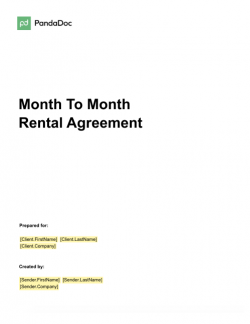Hawaii Month-to-Month Lease Agreement
Developing a Hawaii Month-to-Month Lease Agreement is essential for establishing a flexible and legally compliant rental arrangement within the state's regulations. Hawaii has specific laws governing landlord-tenant relationships, and our Month-to-Month Lease Agreement Template for Hawaii is designed to align with these legal requirements.

Month-to-Month Leases in Hawaii
We look at the laws surrounding month-to-month leases. Knowing these laws ensures that you set up a legally recognized contract.
Lease Termination & Renewal
- The legally required notice of termination in Hawaii is 45 days for the lessor. It differs from the tenant’s notice period, which is 28 to end the lease.
- Month-to-month agreements don’t have particular renewal terms, as the contract continues until someone sends a notice of termination.
Rent Increases
- Hawaii has no laws regarding notice periods or limits for rent increases. As such, it’s up to the discretion of the landlord.
- The general recommendation is to still add a clause about the notice period you give for rent increases.
- Though not required by law, this notice period will be the same as for terminations, that’s to say, 45 days. Further, any rent increase must have a notice of it delivered to the lessee in writing.
Security Deposit
- Hawaii’s laws state that a landlord can’t charge more than one month’s rent as the security deposit. The only exception is if the tenant has a pet. The lessor can ask for an additional month’s rent as part of the security deposit for the increased liability of damages.
- The lessor must return the security deposit within 14 days of the contract’s termination. Termination means the lessee has moved out and returned the keys.
Tenant Rights
- Tenants have a right to a habitable rental unit. They can request repairs for any damages that affect their material health and safety. In this case, the landlord must repair it within a reasonable timeframe after the lessee notifies them of the issue.
- If the landlord doesn’t repair the issue, the tenant can fix the issue and then deduct reasonable repair fees. However, the lessee is responsible for ensuring the lessor receives notice of any problems or damages.
Required Disclosures
Three statutory disclosures are required in this lease. They help tenants serve legal notices or know what the rental unit’s conditions are upon moving in. This state has three primary disclosures every month-to-month lease should have:
- Lead-based Paint Disclosure: If the property is older than 1978, then the landlord must disclose the possibility of lead-based paint. It includes providing an information pamphlet on the hazards of this paint.
- Identification: The lessor must provide the name and address of the property’s managing agent. The lessor must also provide their tax excise number to the lessee.
- Property Condition: The landlord must provide the lessee with a written inventory of the property’s condition before they move in.

